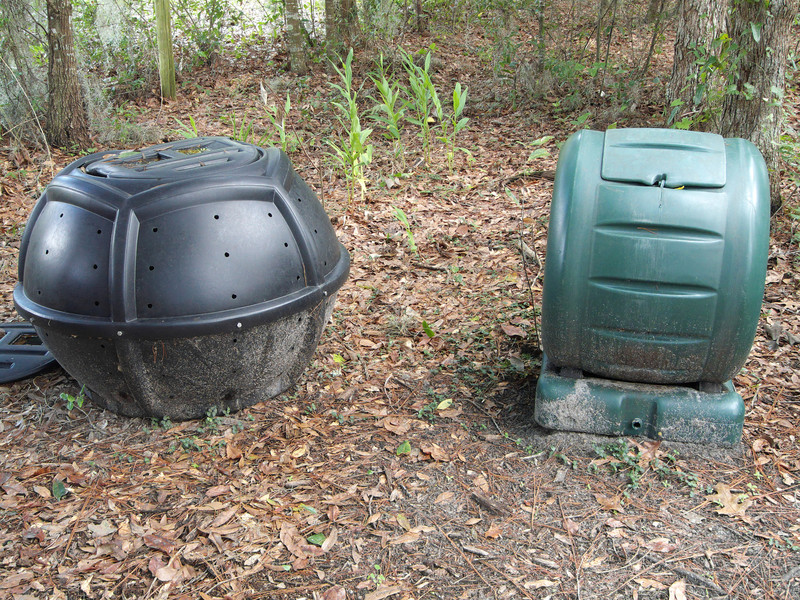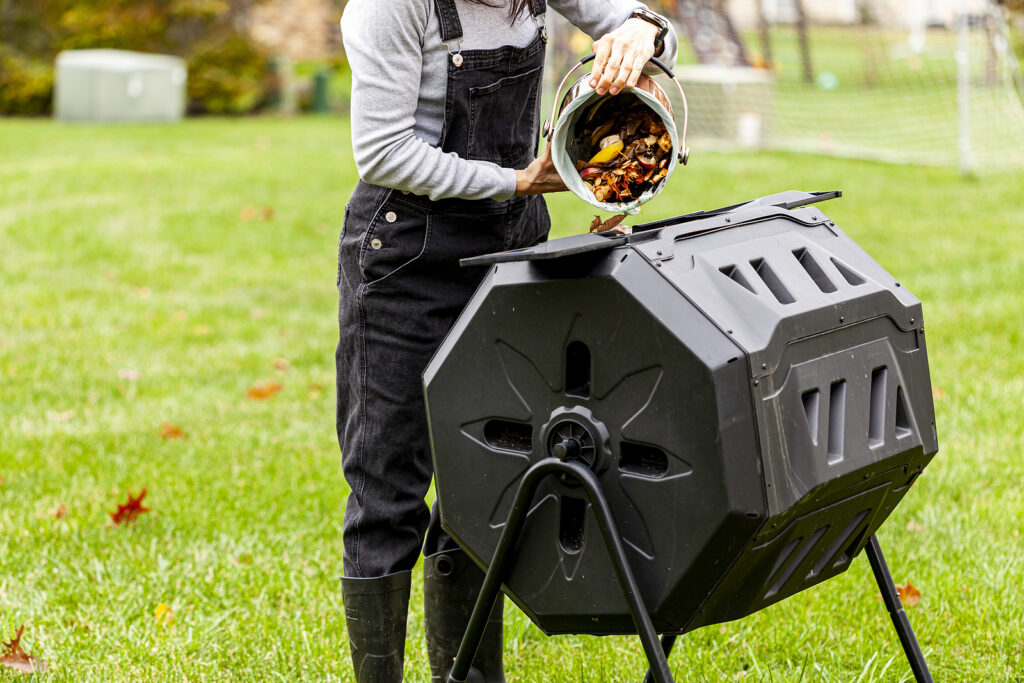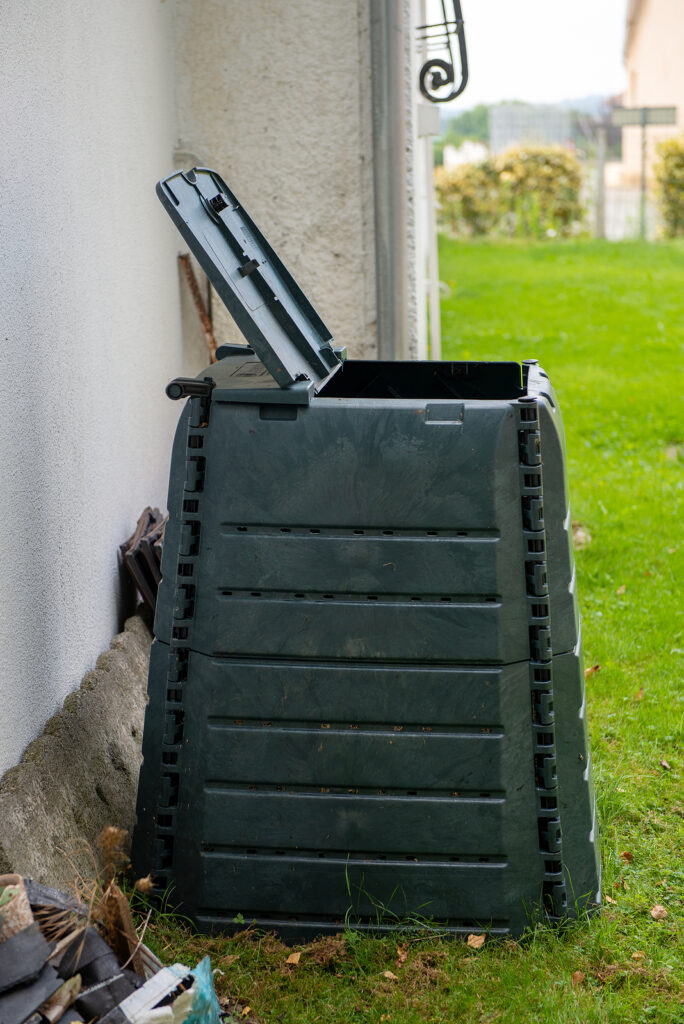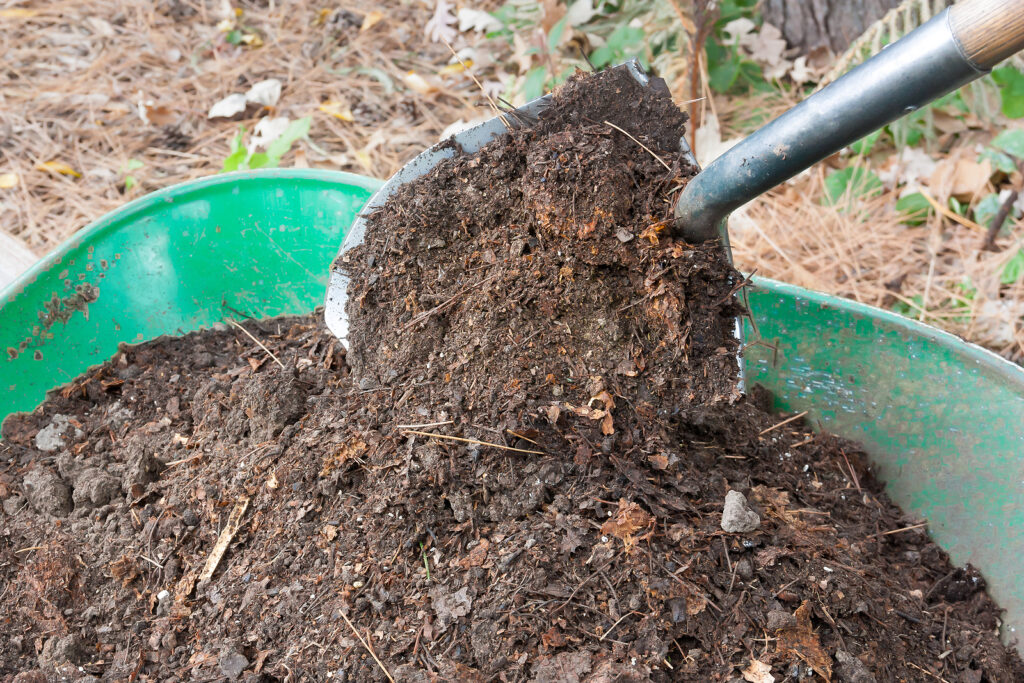A compost bin is a plastic, metal, wood, or wire container where organic material such as leaves, grass clippings, and kitchen scraps is kept during the process of decomposition.
Compost bins help gardeners turn organic material that all too often is thrown away into compost which can improve garden soil and feed plants.
Compost bins — also called composters — can be homemade or store-bought. Ready-made composters often cost you more than the materials for making your own bin, but commercial composters are usually very durable and attractive. A store-bought compost bin can save you the time and effort you’d spend making your own. Many are suitable for small gardens or apartment balconies where space is limited.
Many commercial compost bins are made of recycled plastic which won’t warp or discolor like wood. Compost bins made of dark-colored plastic catch and hold the sun’s heat, making them a good choice for those who live in cold winter climates.
Many ingenious designs have been developed for the purpose of making compost. Some plastic bins resemble barrels or large garbage cans with vented sides. A drum version called a compost tumbler, is mounted on a metal frame allowing the drum to revolve and turn the compost, which speeds up the decomposition action without your having to use a fork or other tool. The simplest and least expensive commercial composter looks much like a large, vented, heavy-duty garbage bag.
Why compost?
- Making compost reduces waste that goes to landfills.
- Composting is not difficult; it is a natural process. Once you set up your compost bin, creating compost is little work.
- Compost creates rich, organic soil amendments that will feed the garden; you save on fertilizers and amendments.
- One year of composting will feed the soil for several years; regular composting will transform your garden.

How compost bins work
A compost bin — or a compost pile — is essentially a heap of vegetable waste and organic matter that generates heat and decomposes naturally with the aid of bacteria and other microorganisms. Inside a compost bin, billions of bacteria, fungi, and other organisms feed on the organic material, grow, reproduce, and die all the time turning kitchen and garden wastes into the excellent organic fertilizer and soil conditioner we call compost. Simply, compost is made as the organic matter breaks down.
Compost bins protect the organic materials and microorganisms from the weather, conserve the heat generated by the microorganisms during composting, and keep out scavenging animals.

Types of compost bins
Here are the most common types of commercial compost bins:
Tumblers – tumbling bins
Tumblers are ready-made barrel-like bins that turn by a handle or crank on the side. Tumblers or drum composters are usually mounted on elevated frames. Some models have gear-driving turning mechanisms, others spin on ball bearings. A crank rotates the bin and mixes the contents. Tumblers make compost quickly if you turn them daily. Tumbling composters aerate and mix ingredients as they are turned. Because tumblers are bottom-heavy, they require strength to turn. Tumblers have a least one drawback, their capacity is usually not very large. You can fill the tumbler to a certain level, then you must stop adding fresh materials until the process has finished.
Compost tumblers are sometimes called “batch” composters. Tumblers may contain one or two compartments for making compost; two compartments or chambers will allow you to start a new batch while the first is finishing composting.
Tumblers usually work more quickly than stationary composters. A tumbler’s turning mechanism will help aerate the organic material which in turn allows microbes to digest the waste more efficiently. Tumblers are usually sealed so heat builds up quickly; this also benefits the waste-eating microorganisms making compost.
Standard stationary four-sided and round insulated bins
Standard four-sided and round stationary bins are perhaps the most common composters. They are often top-loaded with doors at the bottom for removing finished compost. These ready-made plastic or metal bins commonly have insulated sides to hold in the heat. You add organic material at the top and remove the completed compost from the bottom. Insulated bins keep compost warm even in winter; this allows microorganisms to make compost faster and protect the contents from animals. Removeable doors on the sides or at the bottom allow you to scoop out the finished compost. Such bins keep compost warm even in winter and protect the contents from animals.
Some four-sided and round bins have slanted tops and sides that catch just enough rain to maintain moisture levels without drenching the compost. A standard compost bin will require you to turn the compost manually, manual aeration. Turn the compost with an aerator tool or pitchfork. An aerator or compost tool is considerably easier to use than a fork.
Standard compost bins usually have vents that allow you to control the airflow. Vents can be closed or open depending on the weather. Airflow improves the speed of the composting process. Compost bins without vents will have holes for airflow. Manually turning the compost every few weeks will speed composting when using a stationary composter. Turning the compost helps mix and aerate the materials inside.
Standard bins are often made from recycled plastic. Black plastic absorbs solar heat quickly.
Stackables
Stackable plastic compost bins are very similar to the four-sided or round commercial bins but they come in sections, letting you add a section as necessary.
Wire bins
Wire bins are simple four-sided bins made of heavy gauge metal. They are foldable and easy to store when not in use. They often come with waterproof covers to keep rain from soaking the compost. These bins can double as cages for rabbits and small dogs.
Bags
Compost bags are the simplest and least expensive composters. They are commonly plastic bags with reinforced sides. They are easy to set up, easy to take apart, and easy to store.
Worm compost bins
Worm castings or worm compost is one of the richest organic fertilizers. Worm composters, also called vermiculture composters, usually produce about a pound of compost each week. Worm composters used red earthworms to make compost out of kitchen scraps, and vegetable waste; the worms eat the organic matter and poop out the compost–called worm castings. Worms compost organic material when the temperature is between 50 and 80 degrees. Some worm compost bins are odorless and can be used indoors.
Worm composters are often tiered with multiple trays; this allows you to make more than one pound of compost at a time
Kitchen composters, also called food waste processors
Kitchen composters are used for turning kitchen scraps into compost. They are often small enough to sit on a kitchen counter. They usually have a small capacity and the compost can be used for indoor plants. Kitchen composters may have a capacity of just 1 gallon; some that are larger can sit on the kitchen floor out of the way. Choose an indoor composter that has an airtight lid that keeps insects out and a charcoal filter to keep odors from escaping.

Compost bin buying tips
Because of competition and innovation in this field, be sure to shop extensively for the best deal. One thing to keep in mind: commercial composters can be expensive initially but are usually efficient and long-lasting. Here are a few things to look for when buying a compost bin:
Material
Look for a compost bin that is sturdy and durable construction. Compost bins are exposed to the weather year-round. Choose a bin that is water-resistant and can withstand heat and strong UV rays. Commercial bins are commonly made of recycled plastic or metal. Check to make sure the material can withstand the cold where you live as well as summer heat. If you choose a wooden bin, the best choice is cedar wood that has been treated to withstand weather.
Portability
Compost bins can be quite heavy when loaded with organic material. If you plan to move your composter around the garden, be sure to get a model that can be easily moved. Some models, especially tumblers, are too large or heavy to move easily. A portable wheeled bin will allow you to make compost at several sites around the garden.
Capacity
Choose a bin size that can handle the amount of materials you expect to have for composting. However, bigger isn’t always better; if you have only small quantities of composting materials around the garden, two or three inexpensive composters may be a better choice than a single large bin.
Some compost bins have two instead of one chamber. This allows you to start new compost while the old compost is finishing. Two chambers or two bins will allow you to make compost continuously.
A bin with a 40-gallon capacity will provide enough compost for a small to medium-sized garden. A composter with a capacity of 30 gallons or less is suitable for a small garden.
Ease of assembly
Get a bin that is not too complicated to assemble. Bins that come unassembled may have dozens of pieces to screw and bolt together. If possible, read the assembly instructions before you buy.
East of use
If the bin has a loading door or lid, you should be able to lift or open and close it easily. The opening should be wide enough to accommodate bulky material. When considering a drum-type composter check to see that there’s enough room beneath the drum to park a wheelbarrow for unloading the finished compost. Drum-type models should revolve easily; some of the better models hold as much as 18 bushels.
Rebates
Check with your local municipality to see if they offer a rebate on the cost of the bin. Some municipalities subsidize composting to encourage composting and reduce the amount of waste going into landfills.

Compost bin frequently asked questions
Q: What is compost and what is it used for?
A: Compost is made by rotting down vegetable matter. It is used to improve the soil.
Q: What should I look for when buying a compost bin?
A: Look for a compost bin that has ventilated walls, a lift-up panel, and a weatherproof top.
Q: How big of a composter will I need?
A: This depends on how much you plan to compost. A kitchen counter composter will be large enough if you only want to compost kitchen scraps. If you want to compost garden waste, lawn clippings, and kitchen waste, you will want a compost bin with a 30-gallon capacity. That will make enough compost for a small garden.
Q: How long will it take to make compost?
A: Some commercial composters such as tumbling composters can make compost in a month or less. If the organic material is not turned regularly, you can produce usable compost in three to four months in summer and six to eight months in winter.
Q: What material can I put in a composter?
A: All plant material will make compost in the end. Some plant material will compost more swiftly than others. Lawn mowings and vegetable peelings break down quickly. Coarser items such as hedge clippings and tree pruning are best shredded before being added to the compost bin. Here’s a list of organic materials you can compost: annual weeds and plants, coffee grounds and tea leaves, eggshells, lawn clippings, paper torn into small pieces (but not color magazines), straw and hay, spent potting compost, vegetable peelings, withered perennial or partly decomposed leaves and stems, and shredded twigs and branches.

Compost bin use tips
- Place your compost bin on a level surface and make sure it is located in a place convenient for the continuous addition of raw material.
- It is best to keep the top of your compost bin covered to keep rain from drenching the contents. Soggy compost is stinky.
- Make sure there are openings or holes in the bin to ensure air circulation and ventilation; air and ventilation are a necessity for proper decomposition.
- Compost bins with sides that offer insulation will increase the heat within; heat will speed the decomposition of organic material in the bin.
- A bin with some sort of opening for easy removal of compost is a major plus. Often commercial bins will have a door at the bottom that can be opened to remove finished compost.
- The core temperatures inside a compost bin can exceed 160°F, so be careful to keep it away from any material that should not be exposed to such levels of heat.
Compost starter
A compost starter is used to speed up the decomposition process. Compost starter is a mix of bacteria and other microscopic soil organisms in a powder form, sold in containers as well as tablets. Some brands are for composting specific materials only, such as leaves or grass clippings.
Add compost starter to your compost bin to speed up the process of decomposition and to ensure a balanced blend of essential nutrients, Use the appropriate amount of starter for the size of your compost bin.
Compost starters are available under a variety of trade names. Prices vary a great deal, and smaller packages may or may not be a bad deal, depending on how much compost can be created per pound of the product used–some 2-pound boxes made half a ton of compost.
Compost aerator
A composter aerator or compost tool is a metal shaft with a T-handlebar that is used to open, aerate, and turn a compost pile. The tool is easier to use than a fork. A compost aerator is commonly about 30 inches long with a 12-inch long hand with vinyl grips. Most have small hinged paddles at the end of the shaft that fold up flat when the tool is inserted into the compost bin. The paddles open to turn the compost as the tool is pulled and twisted out of the bin.
More Buyer’s Guides



